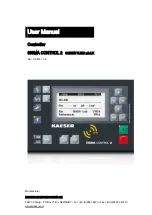
11
Installation/mounting
4
Testing the radio performance
Before permanently installing the system,
check that the siren will receive the system radio
transmission by doing a simple range test.
1
Ensure that the siren’s tamper is disabled.
2
Mount the siren temporarily in the location you
have chosen.
• Use either a masonry nail or a single screw in
the siren base keyhole to temporarily fix in
place.
3
Put the control unit in the chosen position and
arm and disarm as described in Arming and
disarming, and check that the siren responds.
4
Put the control unit into Walk Test mode, as
described in testing the system. Hold the
devices in their chosen positions and activate.
• The PIR and door contact can be tested by
pressing the learn/test button.
• The keypad can be tested by arming and
disarming the system
• The smoke detector can be tested by pressing
the button until the control unit responds.
• The emergency button can be tested by
pressing the button for 2 seconds.
5
When you are satisfied that the devices work in
their chosen locations, proceed with the
installation as described next.
• If the device does not respond, the location
may be out of radio range, try alternative
locations until reliable radio contact is obtained.
• Avoid mounting detectors and the siren on
metal surfaces or by large metal structures.
Alternative mounting methods
Yale provides two methods of mounting,
choose either the self-adhesive pads or the
screws and wall plugs provided.
Self adhesive installation
for door/window
contact
Clean the surface with a suitable degreaser.
Remove he protective covering from one side of
the double-sided adhesive pad and apply firmly to
the back of the door/window contact. Next
remove the other cover and firmly press the
detector on the desired mounting surface.
• Do not use the adhesive pad method of
installation on a surface with peeling or flaky
paint, or on a rough surface.
Screw mounting
Remove the front of the device and, if
necessary, break through the appropriate knockout
(where the plastic is thinner).
Using the holes as a template, drill holes in the
surface and insert the wall plugs if fixing into the
plaster or brick.
Control unit
Open the control unit
and using the 4 holes as
shown, fix the control unit
to a wall as described
under screw mounting.
Ensure the control unit is
fitted at approximately
chest height where the
display can be easily seen and the keypad
convenient to operate.
PIR movement detector
The PIR has a built-in sleep timer to save
battery power. If there is no movement in front of
the PIR for 1 minute, the PIR will become ready to
signal and any movement will be reported. The
PIR will sleep for 1 minute after. Any movement
detected in sleep time will not be reported and
will extend the sleep time by 1 minute. This
feature is designed to conserve battery life.
Ensure that the test/normal mode jumper
switch is in the test ‘on’ position. This reduces the
sleep time to a few seconds and enables the LED
to flash every time movement is detected.
1
Screw the rear case to a flat
wall using the knockouts
shown, as described under
screw mounting methods. The
case has angled back edges for
neat corner mounting. Screw
the PIR front on.
2
Walk around the protected area
noting when the LED flashes
and check that the detection
coverage is adequate.
• Corner mounting is
recommended, as this position
is best for detecting movement across the
PIR’s field of view.
• Remember to wait a few seconds after the PIR
has detected movement.
• Do not try to test the detection pattern by
walking straight up to, or away from the
detector, walk across the field of view.
3
When you are satisfied with the detection
coverage, remove the PIR from its base, place
the jumper in the normal ‘off’ parked position
and screw the PIR back onto its base.
• With the jumper in the normal position the LED
will not normally light unless there is a problem,
Corner fixing
holes x 4
Surface fixing
holes x 2










































